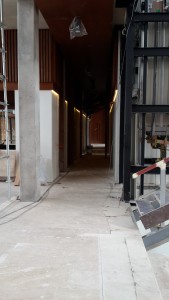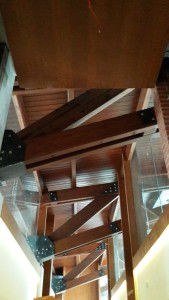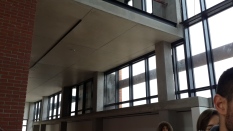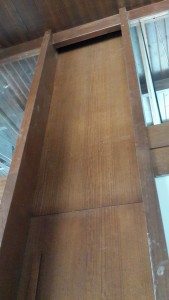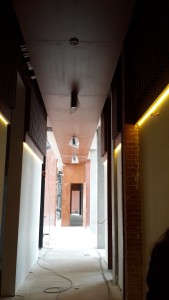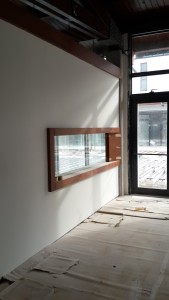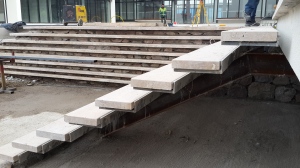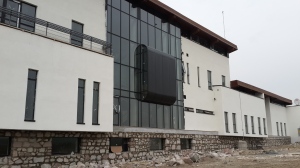What is scale? Scale for what? What kind of scale?
Spaces are created for the usage of people. The usage may change accordingly, but there is always a usage, so, can we say scale is all about usage?
The resemblance between a theatre and architecture is the main excitement about the busy of creation in architecture. The writer of a theatre should arrange all the details of the fiction and the motions, also emotions of the scenes. It gives him a power and if it is used well, the impact of the theatre would be undeniable. The organization of the scenes and escalation of amount of emotion create the impact. As same as theatre, there is a power that provides users some feelings, functions and perception. Actually the way of architecture is to create series of actions for potential users. The motion thing is so related with these arrangements. The arrangement of scale identifies the arrangements of the actions and emotions. For example, before the modernism, because world was on impact of the religion, the message that was wanted to be given to people was that people were weak compared to the God. The religious places were always so important and have very giant scale in order to emphasize the situation of being just human and lead people to pray and believe. The feelings of people who entered the religious spaces were a bit trembled, respectful and peaceful. The messages were directly given. The changes on the world also change the scale of the spaces. For example, in the spaces of modern world, the impact which is wanted to be created is that everybody is equal and people are not so different. So, the houses resemble each other, the spaces are so controlled and generally private ones are smaller than the oldest examples. The religious spaces are also changed in the today’s world, because the function of the religious space is not to create an impact of fear, just create a space for acts of worship. So, the forms of spaces, the importance of visual effects of the spaces are changed in the modern world.
In palaces, in gardens, in boulevards, in religious spaces, in both private and public perceptions are straitened in the modern world. It is the result of the machine ages, modern movement and changes on the life styles of people. The motions of modern people are accelerated. So, transitory spaces are getting important and reshaped. The metros, shopping centers, airports, train stations, roads, pedestrian roads are created according to these new types of motions of people. The motion sometimes lengthens the spaces, and to lead people to be faster, may be straiten. The shapes of spaces are shaped according to the motion which people are wanted to be leaded. So, the scale is the most important tool to manage this. Now on, can we say finally, scale is a portion of motion? I say yes. Then the scale has a function of limiting the both motions and emotions on the scenes of the architectural theatre.
Category: Articles
A trip to Ulus and a breif looking to historical background of Ankara
Ulus was the only living place when Ankara became center of the Independence War of Turks and then capital city of Turkish Republic. In that times, Ulus was a village like place which was not providing conditions of a capital city even in minimum levels. There was no background for a capital city such as old usable buildings, or some places to use for controlling the country. There was a need to have a place as national assembly, and with this building, the capital city, Ankara was started to be founded in Ulus.

A trip we made to Ulus as all students of 301 studio with our lecturer Bilge İmamoğlu, provide me to capture some old buildings which were built in early times of Republic.
Founder of Turkish Republic, Mustafa Kemal Atatürk, made European architects came to Ankara and the first main buildings and boulvards were designed by these architects. For example, Gudrun Baudisch was taking part in presidential house in Çankaya. National Assembly buildings and government buildings were designed by Clemens Holzmeister. The development plan of Ankara was prepared by Hermann Jansen. In addition to them, Ankara as capital of Turkish Republic was created with the touches of important European modern architects such as Ernst Egli, Theodor Jost, Martin Wagner, Martin Elsaesser, Bruno Taut, Robert Oerley.
The Opera Building, and its old design as Exhibition Hall.
Turkish architect Şevki Balmumcu designed the building as Exhibiton Hall and provided the building a very pure, modern form in 1934. Then, in 1948, Paul Bonatz changed the usage of the building, and designed it as a Opera Building. You can see the first form of it on the first picture above, then the final one shows the current building which i took last week in Ulus trip.
http://www.arkitera.com/haber/14101/gecmisin-modern-mimarisi–ankara—2
http://www.goethe.de/ins/tr/ank/prj/urs/arc/bau/trindex.htm
http://www.hurriyet.com.tr/uc-ulkenin-ankaradaki-izleri-30062379
The Working Site Analysis
For our Arch241 course (Structure), we had a trip before 2 weeks into the working site of Anatolian Organized Industrial Zone and its headquarter building which is planned by a team that is directed by Ayşen Savaş and Onur Yüncü. Our lecturer Onur Yüncü has said that he chose this building for the lecture because of being a transperant in terms of structural system. When we went to the site, we also observed the structural system of building easily. None of the structural elements is covered. Material usage, placement of systems, differentiation of spaces and details of the structural organization are all clearly defined in this building. In terms of that situation, it was a very helpful and instructive trip.
The whole building occur 3 main parts. Just one of them has 3 floor (with the underground floor). The others have just one floor because of claims of clients. They wanted a natural, not high warm building in terms of material usage. After that claims, architects convinced them to build 2floor (except the underground) for just one part of the building. Because there are protocol halls and offices in this part of building, so it should be higher than other parts and its experience should give clues about being protocol. The another part of the whole building is the service part of the building which include refectory, kitchen, rooms for heating system and electricity. We can say that the building has a “U” shape, but the service part of the building. That part is near by the “u” but attached.
There are 2 main structural system in whole. One is truss system which is valid for the one floor parts, and the protocol part has post&beam structure. These two main part is differentiated by dilatation of buildings via styrofoam as a 5cm gap. It is required because of possible different placements of different parts of the building. After doing this, it is covered by a decorative material. The transition from the protocol part to single-floor part is also a transition from concrete ceiling to wood truss system. After passing a long continious corridor, we can observe the change of systems.
The columns of protocol part of the building has more tention because of carrying two floor. In order to provide durability, some columns are connected into eachother via reinforcement, and some of them are longer but wider than others, so they can carry much more loading.
 (longer and wider columns 35×70)
(longer and wider columns 35×70)
The other system has also columns as 35×35. The lenght of the columns are changing according to the height of the elements of the truss system. All of the columns and truss elements create a rhythm and its transperancy is controlling spaces. The height of the walls, the sizes of the spaces, all is created according to the structural system. So, the structure and spaces of the building are all interrelated.
The connection of different materials is one of the significant points. The various hinges define these changes.
From the photo above, we can see hinges between two different material, also we can observe the structural system of that part. The wood beams transfer the load into concrete beams, and they transfer it to the columns.
The other thing is that there is a continiuty idea on some doors. In some spaces, the door are create a continious line and it gives an expression of being huge and important, and in somewhere, the door creates a longidutional space.
In second picture, the continious material of door, hides the cables, heating and electricity systems.
The doors between different spaces in corridors provide phsycal disconnection between spaces, but there are gaps between the frame of the doors and the walls.
The inside window, provide a visual connection between a privite space and a public space. While people sitting in their offices, they can have visual experiences with the common space.
The roof and the walls are always seperated via windows. It is also a hinge.
The enterence of the protocol part of the building has staircases which come straigh and stick into the stone. They look like continuing and creating a new thing. This is the important enterence of the building. The cars come here and bring their passengers into the staircase and go into the park area. (underground)
In conclusion, the trip for the construction site was very helpful for our lecture Arch241 and we learned lots of real things which we could not find a opportunity to observe in its site before. The transperant structure elements of building provide us a clear mind about the structure course. The overall design decisions would help us in other lectures also.
Edges of the Medievalism
As i mentioned before, i was supposed to choose a chapter from the “A History of Architecture” written by Spiro Kostof. Then, i chose “Edges of Mediavalism” , chapter 16, and read it. In this stage, i would choose a topic from this chapter, which i would search and write about until the end of this semester. Before choosing, i am supposed to write about general things which Kostof is mentioning about the architectural history, in this chapter.
The chapter “Edged of Medievalism” starts with this statement: “Destined for great things.” This is a city which includes lots of historical and architectural meaning, and also includes much more important names who are historians, artists, sculptors and architects , in its own history. This city took so important role in ideal, artistic and historical development of Europe. Lots of historians and artists showed us that Florence has a special meaning for developing innovative ideas about art, architecture and politics also. Renaissance discussions started in early 15th century in Florence with Brunelleschi, Donatello, Masaccio. Maybe because of the citizens contentious behaviors, maybe because of the Florence’s position in rivalvy, for example with Pisa, Milan, German Emperor, the pope and his defenders, Florence has always included several discussions and violently frictions. The citizens had frictions also with eachother. Every social group and class in Florence is extremly against with eachother. So Kostof says that “Vengefulness was the order of the day” and asks “Which is the truth about Florence? Was she enlightened or grim, a united city or the product of contentious energy?” then he answers: “Both, really.” Although, People who lived in Florence, discuss, fight, even hate each other, they were proud of being Florentines. The one more thing about Florentines was they believed that they are free, although the real situation was different.
In the “City Center” part, writer mentions about the Roman ideal design which is “beautiful, wide and straight” , then Florence had these 3. The city had an order which reflect the order of social and political orderliness. There is a race with Pisa and Siena, but, Florentines were very ambitious about it and this situation created a superiority for Florence. In the early 14th century, the new public buildings started to clarified the visual relationships in the city center. During the 14th century, some disasters couse depopulation in most of Europe, but Florence did not affect these disasters so much. The Hundred Years War between England and France cause lots of damages in terms of population and economical. So all these provide Florence to be better conditions to live, to think, to discuss and to develop.
The changes in life styles had also changed the city places. When people started to get money from country side, they started to move there, so having a place in country side got to be popular. The town houses also changed from its traditional type into a new residential type of house. Writer says “By the mid 14th century the type was in the process of civilizing itself, turning into something more urbane, less dour.” Although all different trials, the churches had still gothic style in Florence.
Overall atmosphere of europe was not so good as Florence. Wars, Black Death, depopulations weakened the Europe. The cities also suffered from financial mismanagements and there were fights between aristocracies and the working classes.
In conclusion, the mediaval age has some decreasing values in Europe, and some positive things in Florence in terms of art, architecture and politic. So this situation creates a base for Renaissance in Florence and it is the thing what the other parts of Europe need. Before Renaissance, Florence has an important role for all devolopments, so the writer mostly mentions about Florence and its role in Europe.
Kostof, Spiro. A History of Architecture, New York and Oxford: Oxford University Press, 2010.
About the Museum of Anatolian Civilizations
The whole building of the museum consists 2 different buildings as Bedesten and Kurşunlu Han. The Bedesten (covered market) was built by Mahmut Pasha in 1455-1466, 1472-1473. The building has 10 domes which cover a central space. It was used for selling clothes. The other building, Kurşunlu Han was built in 1466-1469 by Mahmut Pasha. It is a typical Han building which is traditional architecture of Ottoman Empire. After a fire in 1881, the buildings were out of use. Mustafa Kemal Atatürk, founder of the Turkish Republic, suggested to restore the buildings and manage them as a museum. After he died, restoration work started and it finished in 1968,however the first part of the museum opened in 1943.
The bedesten part of whole building is center of the museum, and there are stone artefacts which are shown and the surrounding spaces are all open to this central hall. Domes are still there and they emphisize the situation of being center and common. The other part of building provides surrounding around the centeral space, so the directing role of the space works as a continious visual trip into the history of Anatolian Civilizations in a very chronological way. The experience of the whole space is managed very well.
In the museum, there are 11 sections which are;
1-Paleolithic Age
2-Neolithic Age
3-Chalcolithic Age
4-Early Bronze Age
5-Assyrian Trade Colonies
6-Hittite
7-Phrygian
8-Urartu
9-Hall of Stone Artefacts
10-Classical Periods
11-Ankara Section
So, the first 8 section is positioned in the surrounding space which opens to the central space from every section. The Hall of Stone Artefacts is the central space which has 10 domes. The other 2 sections are in the floor below, however they are not allowed to enter, so i couldnt observe the spaces there.
In paleolithic age section, there are primitive tools for attacting to animals and some wall drawings which tell us how people were hunting. The neolithic age section includes the Goddess Figurine, the first town plan which shows Çatalhöyük, and more detailed wall drawings. In the chalcolithic age, people started to make dishes from copper. After the warly bronze age, the technique started to be improved time by time, and the tools which people used for daily, are so cleverly designed. It is interesting to observe that people think always in a same way although time is passing and technique and technologie has improved time by time.
The experience of the atmosphere of the all these old ages and also the spaces which reflect the old Ottoman Architecture is instructive and mind-blowing.
THE ISSUE OF THE PUNISHMENT FOR ILLEGAL DOWNLOADING
While technology continues its development, some new experiences in the usage of it bring along some problems such as protection of the content. This situation has ended up with some punishments. For example, people who download music or video illegally are punished. Some say that university students should not be penalized for illegal downloading music, video or other protected context. As an answer for these people, I want to ask something: Why should people be penalized for downloading? I mean that, neither university students nor other people should be penalized for it.
First of all, I am against punishment which is inflicted because of internet downloading. In addition, I am against payment which is paid for downloading. The reason why people should not pay for downloading music or videos from internet, is people already pay money to internet companies for using internet. If it is necessary to pay money, internet companies should pay instead of internet users. Internet companies and music or movie companies should reach an agreement and users should not be responsible for the payment. When this situation is solved, the other problem which is about punishment for illegal downloading will already be solved, because there will not be any crime to punish.
Although I think as I told above, there are still punishments for downloading. If they exist, they should be inflicted to founders of sites where people can download something from. In other words, if downloading is a crime, criminals are founders of sites, not users. In any case, people who download music or videos from internet shouldn’t be punished, because old rules cannot be used for such a new platform. If this platform provides freedom to reach knowledge, music, video or something else, that people download freely should not be a crime.
Some think that especially university students should not be penalized for illegal downloading, because they do not earn money. For example, as a student Pembe Besigni(2008) defends that “We are expected to take the initiative with problem solving. Knowledge and use of free music databases is one way in which we observe this expectation; music costs money which we do not have, so to solve the problem, we go to free music databases and download music”. However, there are lots of people who do not earn money although they are not student; or who are student but earn lots of money at the same time. It is not a clear situation, therefore it is not a good solution. That people download music or videos from internet, is a right for them, if they earn money or not does not matter.
In conclusion, it is wrong to say that university students should not be penalized for illegal downloading, because nobody should be penalized for it. This situation is still quite recent for users and companies, therefore, people try to find a solution for contravention of the content. In my opinion, it is not a good solution to punish people because of it. I suggest competent people find better solutions for this issue.
REFERENCES
Besigni, P.(2008). Retrieved January 2, 2013, from http://www.mhlearningsolutions.com/commonplace/index.php?q=node/3767
CHANGE IN CONCEPT OF LOVE
Every time, love is an issue which is argued. Some say that love was more romantic and real in the past compared to present and interestingly there are a few people who defend that love is effective now as being in the past. This situation is the consequence of three main changes which are about limitations, communication and life conditions.
Although that limitations have been cleared day by day seems a positive effect on love, this situation obviously decreases the depth of love. Since the obstacles were stronger compared to present, lovers of past had more passion in their relationships. There were two main rigid rules which are moral limitations and class distinction. Firstly, moral limitations had a regulating effect on relationships, for example; kissing each other, walking hand-in-hand, hanging out as lovers were considered as immoral if lovers weren’t engaged or married. In addition, if lovers wanted to spend time together, they had to marry as soon as possible in order to prevent gossips or sexual intercourse without marriage. Secondly, class distinction is one of the problems which destroy the relationships between lovers. In the past; discrimination, racism and supremacy were more common and stronger ideas which affected lifestyles and separated people each other according to their features that they could not choose. These thoughts caused bias which affects people about “other” people who didn’t resemble themselves. Then families didn’t allow their children to be friend with “other” families which are in different levels in terms of culture, finance or blood. These all limitations created a term as “impossible love”. Impossibility always creates strong feelings such as greed, passion, rage and love. Impossibility of getting together because of hate of families, strengthened love of Romeo(Luhrmann, 1996). The reason why people can’t love each other such as Romeo and Juliet is that impossible is impossible nowadays.
Communication is one of the most important reasons of ordinary love stories such as meeting on Facebook and marrying, or, finding a partner on a chat room via internet. In addition people mostly prefer telephones or internet to communicate even if they are available for face-to-face communication. While chatting via technological devices, people can’t feel romantic and sensitive, or, can’t transfer their feelings. It probably causes misunderstandings, and there are a lot of ex-relationships which ended because of it. Moreover, this technique of communication can cause overloaded and exhausted relationships. Generally, people tire to send messages each other, and also they can’t miss each other.
The last reason of missing real love time by time is life conditions. Life conditions which have changed day by day press people to spend their time to earn money and stand on their own legs. Effort of earning money and time spent to achieve it, prevent love, and also primacies are changed. In the past, people have more time to think about someone, dream about love, write their feelings as poems, stories… Nowadays there are lots of things which people can dally with. In addition, at the present, nobody can die for feelings of love and revenge such as Catherine (Bronte, 1847). It is about primacies, ways of thinking changed, different things people can concentrate and how people cope with obsessions.
In conclusion, it is impossible to find a pleasure such as falling in love, feeling self as lovesick or missing someone while know that you couldn’t reach , loving only one person forever. These all scenarios were finished with Romeo&Juliet, Ferhat&Şirin, Leyla&Mecnun, Bihter&Behlül, Catherine&Heathcliff… We can only read, listen and watch about them. However, let’s confess it together, as people of today, we don’t really want such a love which destroys and depresses us. So we would content ourselves with listening the stories and go on our lives with our own comfortable, easy-to-act scenarios.
REFERENCES
Luhrmann, B. (Producer/Director). (1996).Romeo and juliet [Motion Picture].USA: 20th Century Fox
Bronte, E. (1847). Wuthering heights. Haworth, England.
CHANGE IN TECHNOLOGY
Can you imagine a life without any technological devices you use every time nowadays? If you are older than 25, your answer would be “yes”, since in our country technology has developed fast but only as recently as 1990’s. Although we reached the technology very late, we got used to it easily and also it is an irreplaceable part of our daily life today. That technology has improved day by day affects human life in terms of many issues such as reaching other people , reaching knowledge and speed of sharing something.
The most significant and undeniable effect of changing technology is that distances have become closer. You can ask how distances can become closer, then it can be told with grouping some examples in terms of transportation, telephones and internet. Firstly, transportation has changed to a large extent via technology. The change of it makes life easier and improves relationships between people. In terms of the relationships, transportation has always been the most effective way which connects people to each other. For instance, in ancient times empires developed In many respects after wars or during trading. It is clear that both of them are about transportation. The reason why transportation makes people and empires improved is that transportation provides seeing new places and people who live there meeting new cultures, getting new ideas, understanding different life styles and also conceiving newness and adapting them to their own culture. So, we can see that the more facilities for transportation mean the more equal levels in terms of life standards and life styles. Thanks to technology, today, people can fly from a mainland to another in a very short time. Additionally, people who can’t dare to go faraway places from where they live because of distance can go anywhere in order to work or study. Secondly, technology had provided people with a device which has been used for talking to each other. Although it was a big event to talk via such a device when telephone was invented, today talking on telephone is not satisfactory, because there are a lot of extra ways for communicating on telephones. So it shows that technology has improved quite fast and it will go on. Thirdly, the internet is a proof which expresses that technology changes and can change everything. Nowadays, mostly people do all necessary works about banks, projects, jobs, homework, researches etc. via internet. Additionally, people can communicate with each other easily and very fast.
The second result of development of technology is that people can reach knowledge about whatever they want easily and fast. The internet provides an opportunity for people in order to search something, use online libraries and ask people something. First of all, if you wonder something about anything, it is enough just to google it. On the one hand it is very useful and easy to access, but on the other hand it may not be reliable, because of it people should be careful while using Google. Online libraries are the other option for researches. Although there were lots of library in the past, people couldn’t go there whenever they want or couldn’t reach knowledge immediately, whereas, today people can learn everything with just one click. Furthermore, if they can’t find a certain point or knowledge about something, they can send e-mail to some people who are experts.
One of the indications of change in technology and also one of the most enjoyable parts of this change is various ways of sharing something. Currently, android telephones are in vogue, since they are really smart devices which people can first take photos, then play with, apply some affects and upload it to a site, which is they compatible with smart phones. In addition, people can record videos, voices and send them immediately instead of a classical message. There are lots of ways to express themselves and that they can be more creative and have more power on what they send makes it enjoyable. So, people love the sites which provide a space for sharing and creating something, such as Facebook, Twitter, Vine, Whatsapp etc. For example, on Facebook, people from every group of age upload photos, share photos or videos, leave comments or “like” them. If people want to share some quotation or their daily status, they use Twitter, and if they want to upload very short videos for fun or giving a message, they choose using Vine. In addition, nowadays Whatsapp is very popular, because most people prefer it instead of messaging in order to send photos, videos, voices or some smileys. The other important improvement is that there is wireless on everywhere today, and it provides opportunity for using internet even people don’t have mobile internet.
In conclusion there are a lot of effects of change in technology on human life, some of which mentioned here even if people don’t realize it sometimes. It is hard to value technology if people were born in last 2 decades, however, people who are older can easily realize how technology has changed. Finally, we can say that, if we live in better conditions than in the past, it is with the help of technology, and if we want to live in better conditions than now, we should contribute to technology and value it. So as to do it, Mohalsaffar (2013) suggests that the government has to look for means to increase the rate of technological development through various ways. Then he adds that it can engage in direct research, providing research subsidies or tax breaks, inviting foreign investors in certain industries or enforcing laws protecting intellectual property.
http://mohalsaffar.wordpress.com/2013/10/30/impacts-of-technological-changes/
Summary and discussion of “Ornament and Crime”
There is a text called “Ornament and Crime” of Adolf Loos which i am going to mention about and discuss the ideas given. First of all i want to summarize the text by focusing main points , then i want to discuss it.
Adolf Loos starts the text such a statement , that, when a child is born, he is considered as amoral like people of ancient times. Then he gives an example, the Papuan kills his enemies and eats them , he is not a criminal, but when modern man kills someone and eats him , he is either a criminal or a degenerate. He adds that although the first work of art was erotic figures on the wall, nowadays, smearing the walls with erotic symbols is a crime or a degeneration. Then the writer has made a discovery and he posses it on to the world: The evolution of culture is synonymous with the removal of ornament from utilitarian objects. However , people state that every age had its style and by style , they meant ornament. Then the writer opposes it. He thinks that the ornamentalists cause demage on aesthetic devolopment, but no one can halt mankind’s evolution. It can only be delayed. However, it is a crime against the national economy that it should result in a waste of human labour, money and material. He claims that , the speed of cultural evolution is reduced by the stragglers. Some says “we prefer a consumer who has a set of furniture that becomes intolerable to him after ten years, and who is consequently forced to refurnish every ten years. Industry demands this. Millions are employed as a result of the quick change.” , he answers this expression with a sardonic approach and says that “How often do we hear someone say when there is a fire: “Thank God, now there will be work for people to do again.” In conclusion, he implicitly defends that ornament is a crime because it forces people to work much more but needlessly. In addition , people of ancient times were doing it unconsciously , but modern people shouldn’t do it although they know ornaments have no function and utility. So , we can’t judge ancient people , because they are considered amoral, however people of modern times are immoral if they give importance ornaments much more than utility.
Although i agree with him in terms of importance of utility and being opposite to inessential labour , if i were writing such a text i don’t want to be certain and accusatory like him. I am not sure to judge ornamentalists as criminal. The writer starts the text by using philosophical ethic terms, these are conclusive, however, while mentioning ethic we can say that intent is important. So i don’t believe that ornamentalist are malevolent, then i don’t think that they are criminal even at modern times. There is a debate about terms of “beauty” and “moral” in philosophy. He directly defends his ideas about both of them, but these are relative terms. I think that we shouldn’t consider ornament in terms of ethic. It is much more about aesthetic. Some may like ornaments or glory things while some prefers simple and pure forms. It is changable. It may change even women by men. If we take into consideration that the writer is male, we can generalize men are less likely to use ornament. On the other hand , most of women like and use ornament in every part of their lifes. Secondly, exaggerating the ornament cause economic detriment especially in terms of national development. For example , devolution times of Ottoman Empire , sultans were destructive in order to prove power of the empire by using glory , deluxe , grand ornament . Then this situation caused a bigger problem for enconomy of the empire and everything went on dreadful . In addition, in modern times, there are lots of rich people who spend their money to shockingly expensive jewelery which embossed with gem stones. Although there are millions of poor people in the world, they spend the money to such a preposterous things. I can agree with that it is harmful and it is immoral. However, we can’t generalize all the ornaments as immoral, and we can’t generalize all the immoral things as a crime.
– Reading: Loos, Adolf. “Ornament and Crime” in: Conrads, Ulrich (ed.) Programs and Manifestoes on 20th Century Architecture, The MIT Press, 1975.
Experiencing Architecture: Basic Observations
I want to summarize a text which i read this week for Arch121 lecture. The text called “Basic Observations” in the book called “Experiencing Architecture” which written by Steen Eiler Rasmussen explains the architecture clearly. It include some issues about architecture such as difference between architecture and other fine arts, relations of architecture and environment , stability of architectural constracts, architectural plans and importance of observations in architecture.
The writer starts with explaning “Fine Arts” which are Architecture, Painting and Sculpture. Altough all of them appeal to the eye , there is a clear difference between architecture and others and it is certainly “Utility”. Architecture should be useful and functional for people who live there. Sculpture and painting don’t have to be beneficial , they can be made for only pleasure. In addition architecture should be coherent and harmonic with its environment, otherwise it can be received as ridiculous. In architecture , one of the most important thing is stability. After building the structure , it should live a long time , therefore it can reach its aim.
That architects should plan every detail clearly and correctly is one of the most fundamental issues. The plan should’t be only correct , it should be also clear and understandable for others. Rasmussen says: “Architecture is produced by ordinary people, for ordinary people; therefore it should be easily comprehensible to all.”
Observations are quite important for architecture. Rasmussen emphasizes that in childhood , people start to observe their environment and they start to play with , see , touch things which are made from different materials and into different shapes. They don’t only discover forms of these things, they also discover functions of them. This process is very useful to understand utility of architecture.
In conclusion, Rasmussen express his own observations in order to emphasize utility of observations in achitecture. It is clear that childhood is quite significant to improve personal perception and understand benefits of things which we live with everytime. Then this functionalism is the main difference between architecture and other fine arts. While building, plans should be distinctly useful so as to build, because of it , they should be correct , objective and clear to understand.
Reading: Rasmussen, S.E. “Basic Observations” in: Experiencing Architecture , Chapman & Hall , 1959 , pp.9-34.







